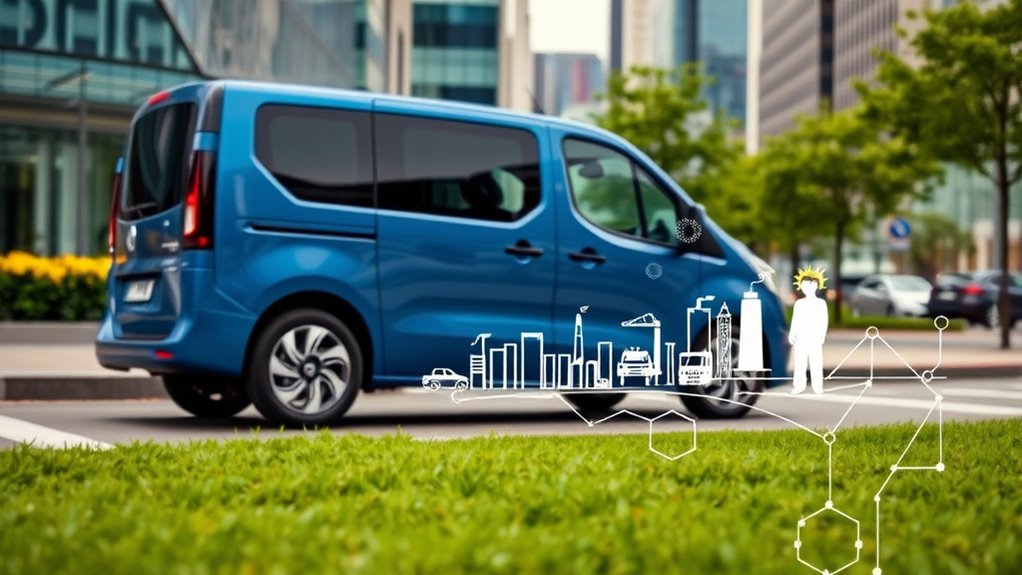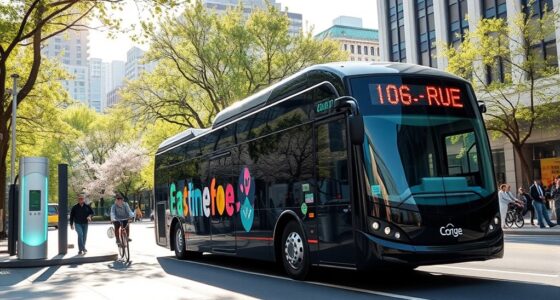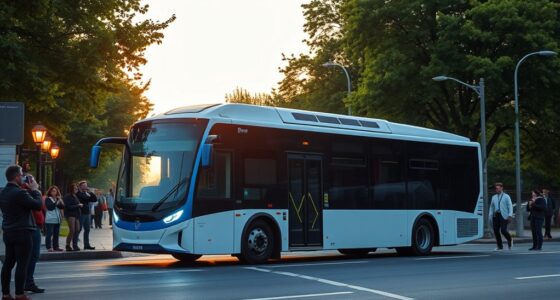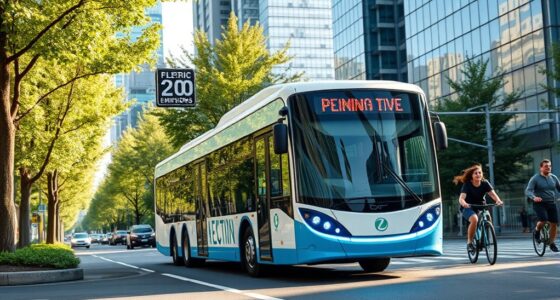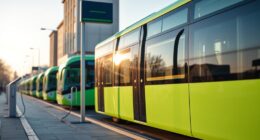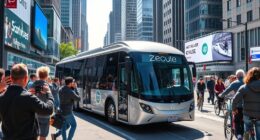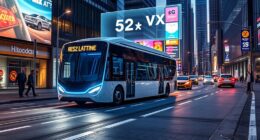The ID.Buzz’s carbon footprint is minimized through sustainable manufacturing, renewable energy use, and eco-friendly materials. Volkswagen certifies its production as carbon-neutral by offsetting emissions from factories, logistics, and component delivery. During use, charging with green energy like solar and wind reduces emissions further. The vehicle also features recycled materials and designs for end-of-life recycling, aligning with broader climate goals. To understand how each of these strategies contributes, explore how Volkswagen is shaping a more sustainable future.
Key Takeaways
- The ID. Buzz’s production is certified carbon-neutral through offsets and renewable energy use, including transportation emissions.
- Lifecycle emissions are minimized by renewable energy-powered manufacturing and sustainable materials like recycled plastics and marine debris textiles.
- Use-phase emissions are nearly zero when charged with green electricity, reducing overall carbon footprint significantly.
- Modular battery design and recycling efforts extend battery lifespan and promote circular economy principles.
- Volkswagen’s long-term climate goals aim for full supply chain neutrality and increased electric vehicle adoption by 2030.
Understanding the Carbon-Neutral Delivery Process
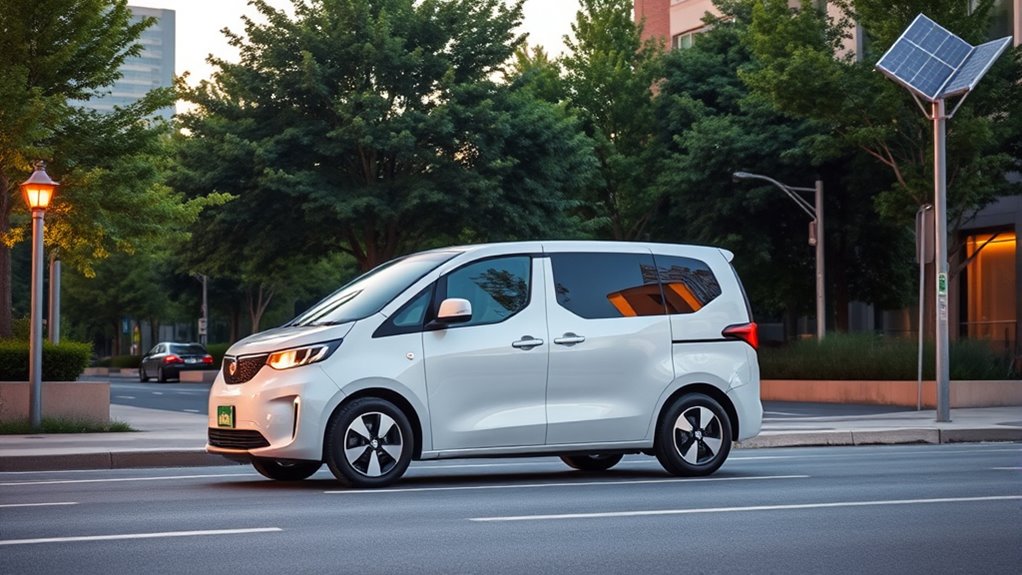
Understanding the carbon-neutral delivery process begins with certification, guaranteeing that emissions from manufacturing to delivery are fully offset. TÜV Nord in Germany certifies the ID. Buzz’s status, confirming that all emissions are compensated through climate protection projects.
This includes emissions from transportation, such as shipping to European customers, which are factored into the offset calculations. You’re encouraged to use renewable energy, like Volkswagen Naturstrom from Elli, to power charging and operations, further supporting sustainability.
The entire supply chain, including component manufacturing, is considered in achieving this neutrality. By managing these elements, Volkswagen ensures that the vehicle’s delivery process minimizes its environmental impact, aligning with its commitment to reducing overall emissions and promoting a sustainable future.
Assessing the Production Lifecycle Emissions
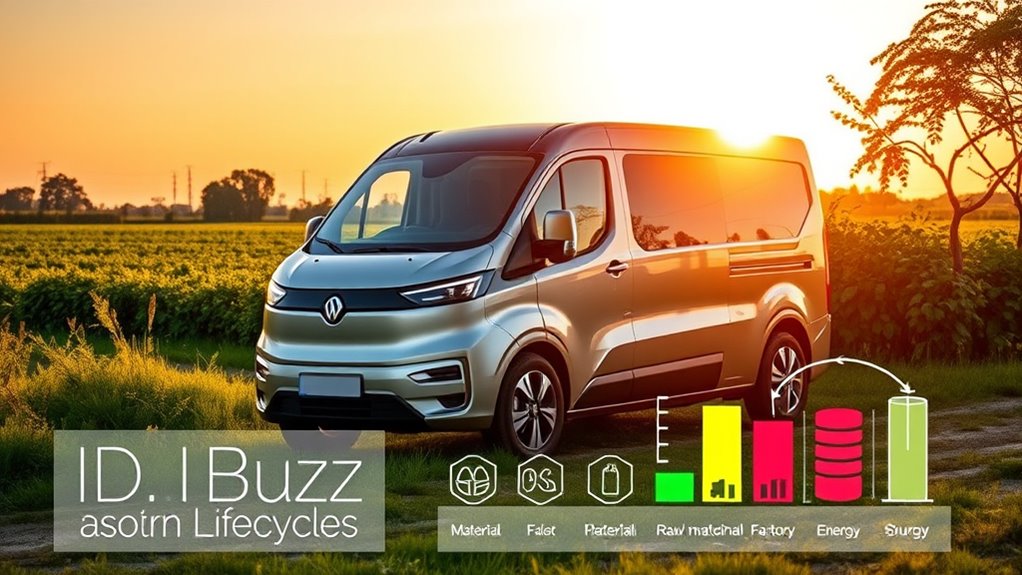
Evaluating the production lifecycle emissions of the ID.Buzz involves analyzing how Volkswagen offsets the environmental impact of manufacturing, logistics, and assembly processes. They claim to achieve carbon-neutral production through offsets covering energy use, refrigerants, and logistics before delivery in Europe. Additionally, implementing sustainable cultivation practices for materials used in production can further reduce overall emissions. Their cradle-to-gate approach excludes emissions from use, recycling, and maintenance. Emissions from component manufacturing are accounted for across Volkswagen’s facilities, with Hannover as the final assembly site. The process includes energy-intensive battery assembly and transportation of parts, while German plants utilize renewable energy where possible. Moreover, carbon offsetting is a critical component of Volkswagen’s strategy to mitigate manufacturing emissions, ensuring alignment with environmental standards. The methodology is certified by TÜV NORD, aligning with GHG Protocol standards. Incorporating life cycle assessment techniques allows for a comprehensive understanding of emissions throughout the production process. Recognizing the importance of emission reduction strategies, Volkswagen continually seeks innovative ways to lower their carbon footprint throughout the entire lifecycle.
Emissions During the Use Phase and Renewable Energy Impact
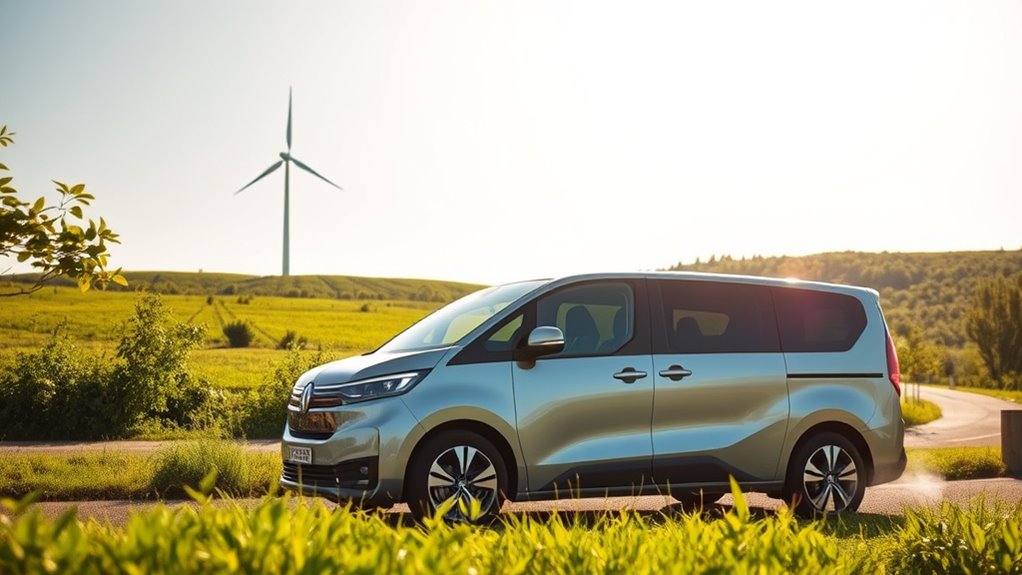
Once the ID.Buzz leaves the production line, its environmental impact shifts primarily to the use phase, where electricity consumption determines its carbon footprint. When powered by renewable energy, the vehicle operates emission-free, drastically reducing its overall emissions. Incorporating clean energy sources into the charging process further enhances its eco-friendliness. Charging with green electricity, like Volkswagen Naturstrom, further minimizes CO2 output, helping to achieve net carbon neutrality. The vehicle consumes about 20.77 kWh per 100 km under WLTP standards, and using renewable sources cuts emissions associated with power generation.
Utilizing solar and wind energy for charging can significantly decrease the vehicle’s carbon footprint, supporting sustainable transportation goals. Volkswagen supports renewable energy projects and offsets remaining emissions through carbon sequestration efforts. Variability in electricity sources influences emissions; however, increasing efficiency and adopting eco-friendly charging habits can substantially reduce the vehicle’s environmental impact. Additionally, integrating sound healing science principles into energy management could support more sustainable and mindful consumption patterns.
Furthermore, adopting energy-efficient charging practices can maximize the environmental benefits of using renewable energy sources.
Material Choices and Their Role in Sustainability
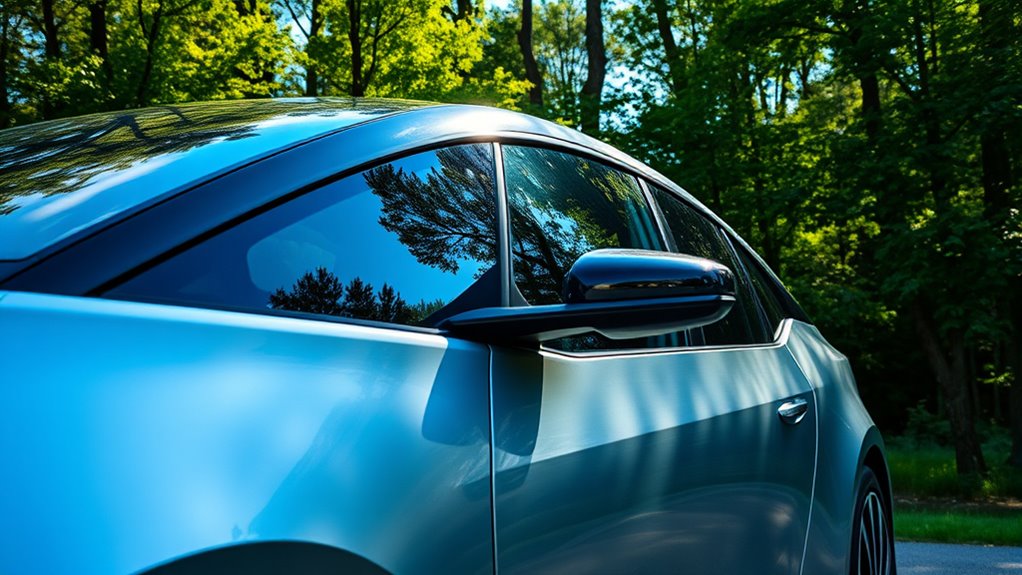
Material choices play a crucial role in making the ID.Buzz more sustainable by reducing its overall environmental impact. You’re using recycled materials like recyclates for body parts, headliner, and flooring, which cut down waste and emissions. The incorporation of SEAQUAL yarn, made from marine debris and recycled PET, reduces CO2 emissions by 32% compared to traditional textiles. Upholstery with ArtVelours ECO, composed of 71% recyclates, further lowers environmental impact. Organic paints and leather-free interiors from renewable sources minimize harmful chemicals and resource depletion. These sustainable materials support a circular economy, repurposing waste and decreasing carbon footprints during production. Additionally, selecting environmentally conscious materials can contribute to long-term sustainability by promoting resource efficiency and reducing ecological harm. Implementing eco-friendly manufacturing processes further enhances the overall sustainability of the vehicle. Embracing innovative material innovation allows manufacturers to develop even more eco-conscious components in the future.
End-of-Life Recycling and Waste Management Strategies

End-of-life recycling and waste management strategies are essential to ensuring the ID.Buzz’s environmental impact is minimized even after it leaves the road. You’ll find that its design emphasizes repairability, with a modular battery that can be serviced easily, reducing the need for full replacements.
Prioritizing repairability and modular design minimizes waste and extends vehicle lifespan.
Batteries are repurposed for secondary applications once their initial use is over, extending their life cycle. Components are designed for recyclability, and high-voltage batteries undergo responsible recycling to recover valuable materials through closed-loop systems. Recycling processes play a vital role in minimizing waste and conserving resources. Implementing circular economy principles further enhances resource efficiency by promoting reuse and recycling of materials at every stage of the product’s lifecycle. Additionally, adopting innovative recycling technologies can significantly improve recovery rates and reduce environmental impact. Advances in automotive recycling methods are continually improving the sustainability of electric vehicle components.
The ID.Buzz also follows circular economy principles, using recycled materials and optimizing waste management with digital tracking. Waste reduction efforts, including reusing plastics and recovering raw materials, align with strict environmental regulations.
Volkswagen’s Broader Goals for Climate Neutrality
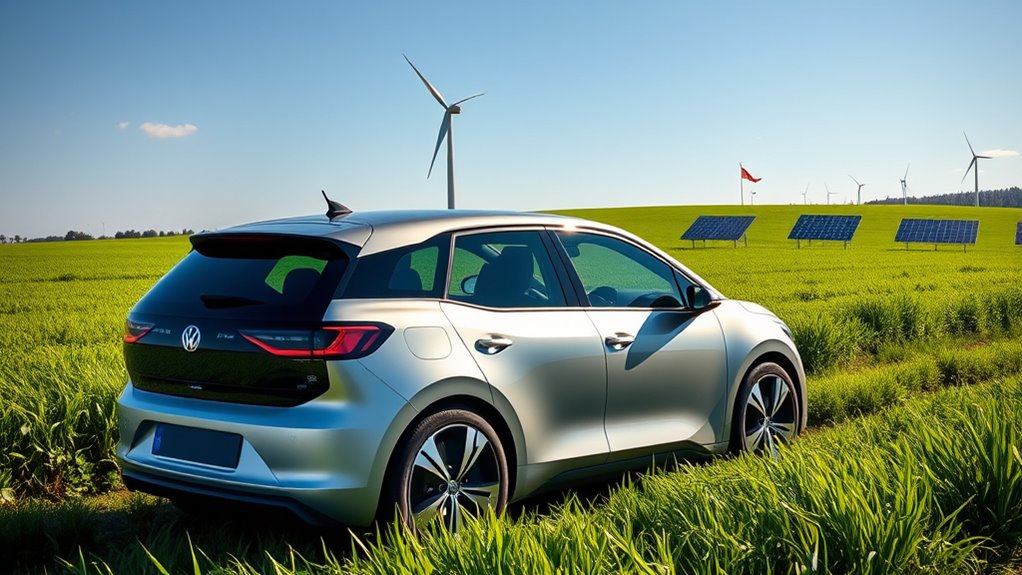
Volkswagen is taking bold steps toward achieving climate neutrality across its entire operations, building on its focus on sustainable vehicle design and waste management.
The company aims for net carbon-neutral production sites by 2040, ten years ahead of initial plans, with a target of 40% CO2 reduction per vehicle in Europe by 2030. This ambitious timeline demonstrates a strong commitment to climate action and long-term sustainability.
By then, 70% of sales in Europe and 50% in North America and China will be electric.
Volkswagen plans €14 billion in decarbonization investments by 2025 and to power all European plants with 100% renewable energy by 2030.
Its goals include full supply chain neutrality by 2050, with efforts spanning energy projects, renewable energy use, and fleet optimization.
Additionally, integrating mental wellbeing initiatives within corporate sustainability programs can enhance employee resilience and engagement in these transformative efforts. Emphasizing sustainable manufacturing practices further supports these climate goals by reducing resource consumption and waste. These initiatives position Volkswagen as a leader in corporate sustainability and climate action.
How the ID. Buzz Contributes to a Sustainable Future
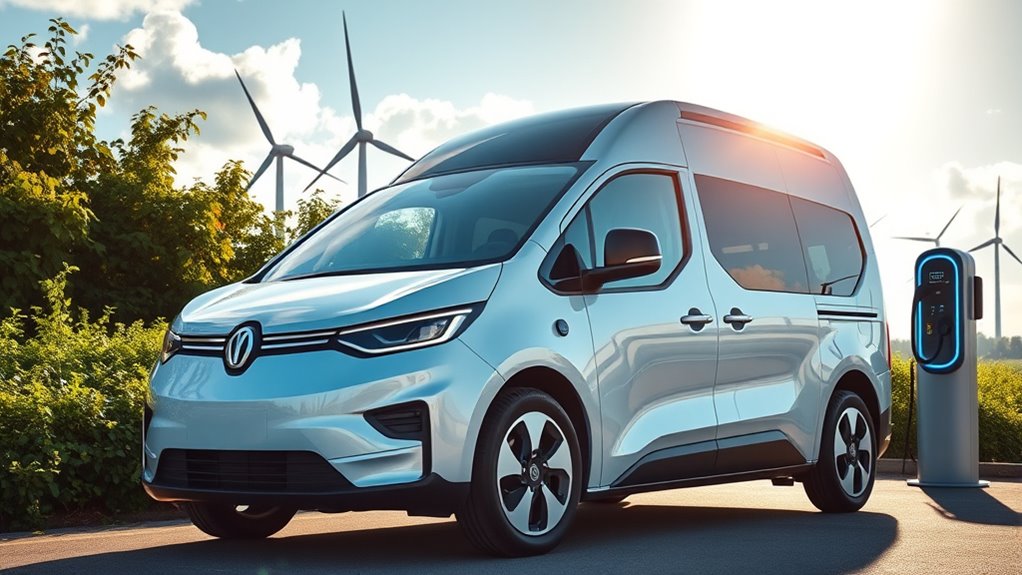
The ID. Buzz contributes to a sustainable future by integrating eco-friendly materials and innovative design. You benefit from recycled seat upholstery made with 71% recycled materials, reducing waste and environmental impact. Vetted – Nightingale Studio also emphasizes the importance of sustainable manufacturing practices in reducing overall carbon footprints. Interior fabrics contain threads made from marine plastic and recycled PET bottles, cutting carbon emissions by 32%. Its paint uses organic formulations, further lowering VOC emissions. Animal-free materials replace leather, supporting ethical sourcing. The manufacturing process incorporates energy-efficient techniques and renewable energy sources to minimize greenhouse gas emissions. The battery is designed for repair and second-life applications, extending its usefulness and reducing waste. A responsible recycling system ensures batteries are properly disposed of or repurposed. Production is carbon-neutral, utilizing recycled plastics, water-based adhesives, and localized manufacturing. These efforts make the ID. Buzz a tangible step toward a sustainable future, emphasizing resource efficiency and circularity. Incorporating carbon footprint reduction strategies is essential in the evolving landscape of sustainable transportation.
Frequently Asked Questions
How Does the ID. Buzz’s Production Emissions Compare to Traditional Vehicles?
Your question about the ID. Buzz’s production emissions versus traditional vehicles highlights that EV manufacturing typically results in higher initial emissions, mainly due to battery production. However, the ID. Buzz reduces this impact by using 71% recycled materials and innovative plastics.
While its production is more emissions-intensive upfront, these efforts help offset the difference over the vehicle’s lifespan, making it a greener choice compared to conventional vehicles.
What Specific Projects Offset the Vehicle’S Carbon Footprint?
Imagine lush forests and solar farms thriving as your vehicle’s footprint shrinks. You offset the ID.Buzz’s emissions through projects like reforestation efforts that plant trees, renewable energy infrastructure that powers communities, and methane capture initiatives reducing greenhouse gases.
These high-standard, UN-certified projects directly counteract emissions from production, materials, and logistics, ensuring your eco-friendly ride contributes to a greener planet. Your choice supports sustainable development and climate action.
How Does Vehicle Weight Affect Its Overall Sustainability?
You see, vehicle weight directly impacts its sustainability by influencing energy use, emissions, and efficiency.
When you reduce weight, you lower energy consumption, which cuts greenhouse gases and operational costs.
Lighter vehicles also perform better, have increased payloads, and meet stricter regulations more easily.
Are There Future Materials Planned to Enhance Eco-Friendliness?
Think of future materials as the seeds of a greener future. You’ll see innovations like coffee leather replacing animal products, biomaterials reducing environmental impacts, and cellulose-based options for organic components.
Volkswagen plans to expand these eco-friendly materials across models, aiming for a 40% carbon reduction by 2030. These advancements are like building blocks that help you drive more sustainably and move closer to a cleaner, healthier planet.
How Does VW Ensure Recycling Processes Remain Environmentally Responsible?
You can be certain that VW keeps recycling environmentally responsible by designing the ID. Buzz for easy dismantling and using high-value, recyclable materials. They prioritize recycled plastics, marine debris, and batteries, recovering raw materials for reuse in a closed-loop system.
VW also avoids harmful substances like chrome, opting for eco-friendly alternatives. Their transparent supply chain and focus on sustainability ensure recycling processes minimize environmental impact and promote a circular economy.
Conclusion
Think of the ID. Buzz as a beacon guiding you through a greener future, each step shedding light on sustainability. By understanding its lifecycle emissions, material choices, and recycling efforts, you become part of a movement steering away from carbon shadows. Volkswagen’s commitment is like a steady heartbeat, pulsing with hope. Together, you can help turn the wheels toward a cleaner planet, making the journey as impactful as the destination.
